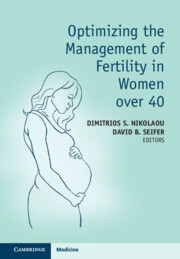Book contents
- Optimizing the Management of Fertility in Women over 40
- Optimizing the Management of Fertility in Women over 40
- Copyright page
- Dedication
- Contents
- Contributors
- Introduction
- Section 1 Demographic Trends
- Section 2 Biological Basis of Female Reproductive Aging: What Happens to the Ovaries and the Uterus as they Age?
- Section 3 Lifestyle, Environment, and Optimizing Reproduction in the 40s
- Section 4 Rethinking and Redefining “Family Planning” for the Twenty-First Century
- Section 5 Optimal Deployment of ART beyond 40
- Section 6 Obstetric Management beyond 40
- Section 7 Children of Older Parents
- Section 8 What Are Realistic Alternatives to Conceiving with Autologous Eggs?
- Section 9 New Technologies
- Chapter 14 Is It Likely That Reproductive Aging Could Be Delayed or Reversed Using Advanced Technologies in the Future?
- Section 10 Ethics
- Index
- References
Chapter 14 - Is It Likely That Reproductive Aging Could Be Delayed or Reversed Using Advanced Technologies in the Future?
from Section 9 - New Technologies
Published online by Cambridge University Press: 15 September 2022
- Optimizing the Management of Fertility in Women over 40
- Optimizing the Management of Fertility in Women over 40
- Copyright page
- Dedication
- Contents
- Contributors
- Introduction
- Section 1 Demographic Trends
- Section 2 Biological Basis of Female Reproductive Aging: What Happens to the Ovaries and the Uterus as they Age?
- Section 3 Lifestyle, Environment, and Optimizing Reproduction in the 40s
- Section 4 Rethinking and Redefining “Family Planning” for the Twenty-First Century
- Section 5 Optimal Deployment of ART beyond 40
- Section 6 Obstetric Management beyond 40
- Section 7 Children of Older Parents
- Section 8 What Are Realistic Alternatives to Conceiving with Autologous Eggs?
- Section 9 New Technologies
- Chapter 14 Is It Likely That Reproductive Aging Could Be Delayed or Reversed Using Advanced Technologies in the Future?
- Section 10 Ethics
- Index
- References
Summary
This chapter explores new technologies for overcoming the problem of deteriorating oocyte-quality with age. It includes brief discussions of the following: mitochondrial replacement therapy, cytoplasmic transfer, autologous germline mitochondrial energy transfer (AUGMENT), maternal spindle transfer (MTS), in vitro activation of dormant follicles, autologous activated platelet-rich plasma injections (PRP), in vitro gametogenesis, induced pluripotent stem cells (iPSCs), aneuploidy correction through gene-editing and artificial ovaries. Clinicians should exercise extreme caution in managing patient expectations regarding these novel technologies. While clinical application of stem cell technology for maternal age-related infertility does seem likely at some point in the future, the timeline remains uncertain.
Keywords
- Type
- Chapter
- Information
- Optimizing the Management of Fertility in Women over 40 , pp. 163 - 172Publisher: Cambridge University PressPrint publication year: 2022



